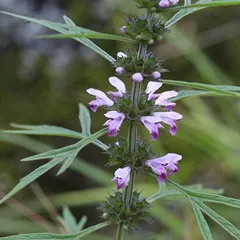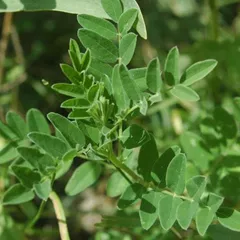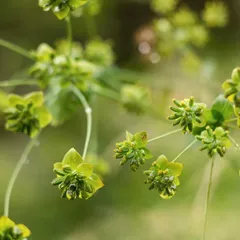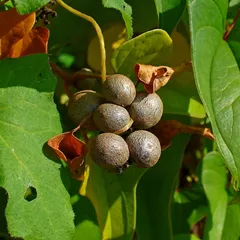Ba Zhen Tang
Ba Zhen Tang
Chinese: 八珍汤
Pinyin: Bā Zhēn Tāng
Other names: Eight Treasure Decoction, Eight Substance Decoction
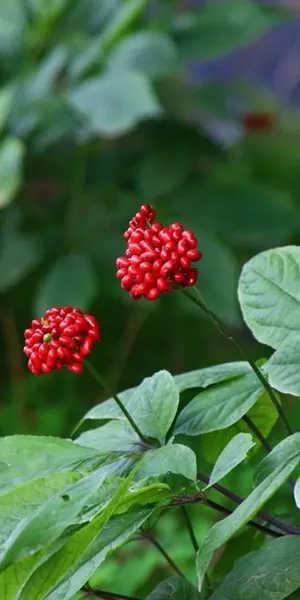
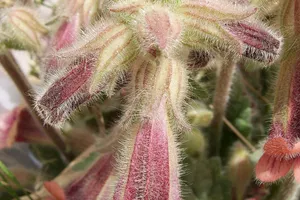
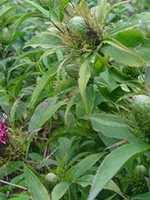
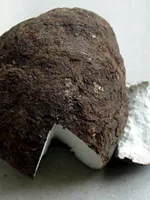




Ba Zhen Tang
Ba Zhen Tang
Chinese: 八珍汤
Pinyin: Bā Zhēn Tāng
Other names: Eight Treasure Decoction, Eight Substance Decoction
Number of ingredients: 10 herbs
Formula category: Formulas that tonify Qi and Blood
Conditions for which it may be prescribed: AnemiaUlcersHepatitis and four other conditions
- Tonifies and augments Qi
- Tonifies and augments Blood
Source date: 1326 AD
Source book: Experiential Formulas from the Auspicious Bamboo Hall
The information provided here is not a replacement for a doctor. You shouldn't use it for the purpose of self-diagnosing or self-medicating but rather so you can have a more informed discussion with a professional TCM practitioner.
Ba Zhen Tang is a 10-ingredient Chinese Medicine formula with Ginseng (Ren Shen) and Prepared Rehmannia (Shu Di huang) as principal ingredients.
Invented in 1326 AD, it belongs to the category of formulas that tonify Qi and Blood. Its main actions are: 1) tonifies and augments Qi and 2) tonifies and augments Blood.
In Chinese Medicine health conditions are thought to arise due to "disharmonies" in the body as a system. These disharmonies are called "patterns" and the very purpose of herbal formulas is to fight them in order to restore the body's harmony.
In this case Ba Zhen Tang is used by TCM practitioners to fight patterns like Lung Qi Deficiency, Spleen Qi Deficiency or Qi and Blood Deficiency. From a Western Medicine standpoint, such patterns can give rise to a range of conditions such as spontaneous flow of breast milk, anemia or hepatitis for instance.
On this page, after a detailed description of each of the ten ingredients in Ba Zhen Tang, we review the patterns and conditions that Ba Zhen Tang helps treat.
The ten ingredients in Ba Zhen Tang
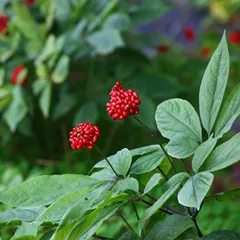
Ren Shen is a king ingredient in Ba Zhen Tang. Like the name indicates, it means it has more power than other ingredients in the formula.
1. Ginseng (Ren Shen)
Part used: Dried root
Nature: Warm
Meridian affinity: HeartLungSpleen
Category: Tonic herbs for Qi Deficiency
In general Ren Shen's main actions are as follows: "Very strongly tonifies the Qi. Tonifies the Lungs and Spleen. Assists the body in the secretion of Fluids and stops thirst. Strengthens the Heart and calms the Shen (mind/spirit)."
In the context of Ba Zhen Tang, it is used because it is warming in nature and augments the Qi.

Shu Di huang is a king ingredient in Ba Zhen Tang. Like the name indicates, it means it has more power than other ingredients in the formula.
2. Prepared Rehmannia (Shu Di huang)
Part used: Prepared dried root tuber
Nature: Warm
Taste(s): Sweet
Meridian affinity: KidneyLiver
Category: Tonic herbs for Blood Deficiency
In general Shu Di huang's main actions are as follows: "Tonifies the Blood. Tonifies the Yin of the Kidneys."
In the context of Ba Zhen Tang, it is used because it nourishes the Blood.
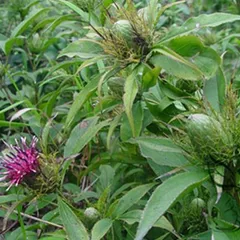
Bai Zhu is a deputy ingredient in Ba Zhen Tang. This means it helps the king ingredient(s) treat the main pattern or it serves to treat a coexisting pattern.
3. Atractylodes Rhizomes (Bai Zhu)
Part used: Dried rhizome
Nature: Warm
Meridian affinity: SpleenStomach
Category: Tonic herbs for Qi Deficiency
Bai Zhu strengthens the Spleen and dry Dampness. Therefore it helps the main ingredient Ren Shen (Ginseng) in fortifying the Spleen and Lungs Qi.
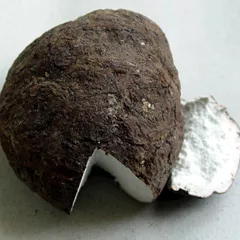
Fu Ling is a deputy ingredient in Ba Zhen Tang. This means it helps the king ingredient(s) treat the main pattern or it serves to treat a coexisting pattern.
4. Poria-Cocos Mushrooms (Fu Ling)
Part used: Dried sclerotium
Nature: Neutral
Taste(s): Sweet
Meridian affinity: HeartKidneyLungSpleen
Category: Herbs that drain Dampness
In general Fu Ling's main actions are as follows: "Encourages urination and drains Dampness. Tonic to the Spleen/Stomach. Assists the Heart and calms the Spirit."
In the context of Ba Zhen Tang, it is used because it strengthens the Spleen and dry Dampness.
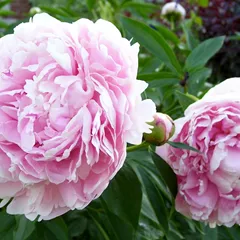
Bai Shao is a deputy ingredient in Ba Zhen Tang. This means it helps the king ingredient(s) treat the main pattern or it serves to treat a coexisting pattern.
5. White Peony Roots (Bai Shao)
Part used: Dried root
Nature: Neutral
Meridian affinity: LiverSpleen
Category: Tonic herbs for Blood Deficiency
Bai Shao nourishes Blood and helps reinforcing the action of the king ingredient Shu Di Huang (Prepared rehmannia).
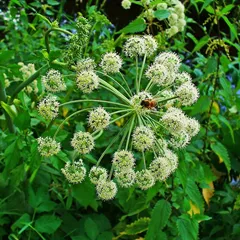
Dang Gui is a deputy ingredient in Ba Zhen Tang. This means it helps the king ingredient(s) treat the main pattern or it serves to treat a coexisting pattern.
6. Dong Quai (Dang Gui)
Part used: Dried root
Nature: Warm
Meridian affinity: HeartLiverSpleen
Category: Tonic herbs for Blood Deficiency
Dang Gui nourishes Blood and therefore helps reinforcing the action of the king ingredient Shu Di Huang (Prepared rehmannia).
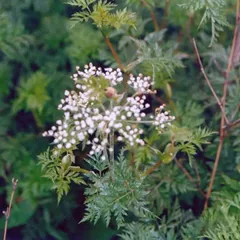
Chuan Xiong is an assistant ingredient in Ba Zhen Tang. This means that it either serves to reinforces the effect of other ingredients or it moderates their toxicity.
7. Szechuan Lovage Roots (Chuan Xiong)
Part used: Dried rhizome
Nature: Warm
Taste(s): Pungent
Meridian affinity: GallbladderLiverPericardium
Category: Herbs that invigorate the Blood
In general Chuan Xiong's main actions are as follows: "Regulates and moves the Blood. Relieves Wind-Cold and pain. Circulates the Qi in the Upper Burner, relieving headaches."
In the context of Ba Zhen Tang, it is used because it promotes Qi movement and invigorates Blood.
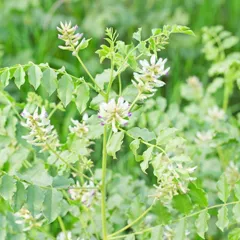
Gan Cao is an assistant ingredient in Ba Zhen Tang. This means that it either serves to reinforces the effect of other ingredients or it moderates their toxicity.
8. Liquorice (Gan Cao)
Part used: Dried root and rhizome
Nature: Neutral
Taste(s): Sweet
Meridian affinity: HeartLungSpleenStomach
Category: Tonic herbs for Qi Deficiency
In general Gan Cao's main actions are as follows: "Tonifies the Basal Qi and nourishes the Spleen Qi. Clears Heat and dispels toxicity. Moistens the Lungsexpel phlegm and stop coughing. Relieves spasms and alleviates pain. Harmonizes and moderates the effects of other herbs."
In the context of Ba Zhen Tang, it is used because it supplies Qi and harmonizes the Middle Burner.

Sheng Jiang is an envoy ingredient in Ba Zhen Tang. This means that it directs the formula towards certain area of the body and/or harmonizes the actions of other ingredients.
9. Fresh Ginger (Sheng Jiang)
Sheng Jiang regulates Stomach and Spleen's absorptive function. This is important because it helps the other herbs in the formula to be absorbed. It also regulates the relationship between the Protective (Wei Qi 卫气) and Nutritive Qi (Rong Qi 荣气), which helps patients suffering from Blood and Qi Deficiency to recover without developing other issues.
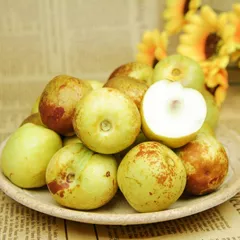
Da Zao is an envoy ingredient in Ba Zhen Tang. This means that it directs the formula towards certain area of the body and/or harmonizes the actions of other ingredients.
10. Jujube Dates (Da Zao)
Part used: Dried ripe fruit
Nature: Warm
Taste(s): Sweet
Meridian affinity: SpleenStomach
Category: Tonic herbs for Qi Deficiency
Da Zao regulates Stomach and Spleen's absorptive function, thereby helping the other herbs in the formula to be absorbed.
Conditions and patterns for which Ba Zhen Tang may be prescribed
It's important to remember that herbal formulas are meant to treat patterns, not "diseases" as understood in Western Medicine. According to Chinese Medicine patterns, which are disruptions to the body as a system, are the underlying root cause for diseases and conditions.
As such Ba Zhen Tang is used by TCM practitioners to treat four different patterns which we describe below.
But before we delve into these patterns here is an overview of the Western conditions they're commonly associated with:
Spontaneous flow of breast milk Anemia Hepatitis Abnormal uterine bleeding Habitual miscarriage Ulcers Nervous exhaustion
Again it wouldn't be correct to say "Ba Zhen Tang treats spontaneous flow of breast milk" for instance. Rather, Ba Zhen Tang is used to treat patterns that are sometimes the root cause behind spontaneous flow of breast milk.
Now let's look at the four patterns commonly treated with Ba Zhen Tang.
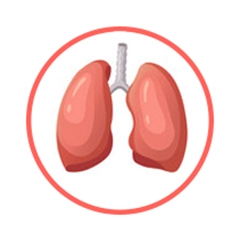
The Lungs is a so-called "Zang" Organ. Learn more about the Lungs in Chinese Medicine
Lung Qi Deficiency
Pulse type(s): Empty (Xu)
Tongue color: Pale
Symptoms: Coughing Pale face Tiredness Weak voice Low energy Aversion to cold Aversion to speak Shortness of breath Propensity to catch colds Spontaneous daytime sweating
Ba Zhen Tang is sometimes prescribed by TCM practitioners to treat Lung Qi Deficiency. This pattern leads to symptoms such as spontaneous daytime sweating, aversion to speak, shortness of breath and coughing. Patients with Lung Qi Deficiency typically exhibit empty (Xu) pulses as well as Pale or normal color tongue.
The Lungs govern Qi and respiration. Therefore there will be shortness of breath and coughing in case of Lung Qi Deficiency. However the condition is not severe as it is mostly on exertion and not full-blown symptoms of bronchitis or asthma.
Symptoms like coughing can also appear if Lungs' Qi... read more about Lung Qi Deficiency

The Spleen is a so-called "Zang" Organ. Learn more about the Spleen in Chinese Medicine
Spleen Qi Deficiency
Pulse type(s): Empty (Xu)
Tongue color: Pale
Symptoms: Gas Obesity Fatigue Bloating Lassitude Pale face Overweight Weak Limbs Weak voice Loose stools Poor appetite Poor digestion Pale complexion Desire to lie down Swollen complexion Slight abdominal pain Weakness in the limbs Slight abdominal distension after eating
Ba Zhen Tang is sometimes prescribed by TCM practitioners to treat Spleen Qi Deficiency. This pattern leads to symptoms such as slight abdominal distension after eating, lassitude, desire to lie down and slight abdominal pain. Patients with Spleen Qi Deficiency typically exhibit empty (Xu) pulses as well as Pale or normal tongue with thin white coating. Possible swollen with tooth marks on sides and transverse cracks.
Spleen Qi Deficiency is one of the most commonly seen disharmony. The three most common causes for this pattern are unhealthy diet, emotional stress and mental-excertion as they can largely harm the transformation and transportation function of the Spleen. This pattern gives rise to various... read more about Spleen Qi Deficiency
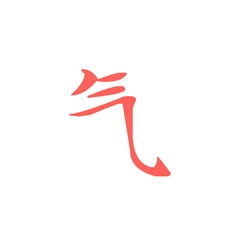
Qi is one of Chinese Medicine's vital subtances. Learn more about Qi in Chinese Medicine
Qi and Blood Deficiency
Pulse type(s): Slowed-down (Huan), Weak (Ruo), Fine (Xi)
Tongue coating: Partial absence of coating
Tongue color: Pale
Symptoms: Edema Fatigue Vertigo Anxiety Insomnia Dry hair Dry skin Dry lips Tingling Numbness Dry eyes Pale face Dizziness Pale lips Hair loss Tiredness Sore back Weak voice Sore knees Depression Low energy Poor memory Pale tongue Watery milk Palpitations Listlessness Loose stools Poor appetite Scanty periods Blurred vision Low milk supply Pale complexion General weakness Aversion to speak Pale color periods Shortness of breath Numbness in the skin Spontaneous sweating Lower abdominal pain Pale menstrual blood Numbness in the limbs Dream disturbed sleep Dull menstrual cramps Feeling of bearing down Thin and watery periods Withered and brittle nails Thin body lacking strength Pain relieved with massage Lethargic and withdrawn state Spontaneous flow of breast milk Menstruation decreases gratually No feeling of distension of the breasts Insufficient or absent lactation after childbirth
Ba Zhen Tang is sometimes prescribed by TCM practitioners to treat Qi and Blood Deficiency. This pattern leads to symptoms such as general weakness, fatigue, weak voice and pale face. Patients with Qi and Blood Deficiency typically exhibit slowed-down (Huan), weak (Ruo) or fine (Xi) pulses as well as Pale tongue with thin white coating .
The Qi and Blood are from the some origin and these two elements are transformable between each other. The Qi creates the Blood, and vice versa the Blood supplies Qi. Therefore it is quite common both patterns appear at the same time.
When general Qi is Deficient, the patients lack the energy to... read more about Qi and Blood Deficiency

The Spleen is a so-called "Zang" Organ. Learn more about the Spleen in Chinese Medicine
Spleen and Stomach Qi Deficiency
Pulse type(s): Weak (Ruo)
Tongue color: Pale
Symptoms: Fatigue Deafness Tinnitus Belching Vomiting Diarrhea Dizziness Pale face Pale lips Weak voice Watery milk Unsteadiness Loose stools Poor appetite Blurred vision Pale complexion Shortness of breath Abdominal distension Lower abdominal pain No feeling of distension of the breasts Insufficient or absent lactation after childbirth
Ba Zhen Tang is sometimes prescribed by TCM practitioners to treat Spleen and Stomach Qi Deficiency. This pattern leads to symptoms such as dizziness, unsteadiness, blurred vision and deafness. Patients with Spleen and Stomach Qi Deficiency typically exhibit weak (Ruo) pulses as well as a pale tongue.
Formulas similar to Ba Zhen Tang
Ba Zhen Yi Mu Tang is 80% similar to Ba Zhen Tang
Shi Quan Da Bu Tang is 80% similar to Ba Zhen Tang
Ren Shen Yang Rong Tang is 64% similar to Ba Zhen Tang
Bu Zhong Yi Qi Tang is 60% similar to Ba Zhen Tang
Jia Wei Xiao Yao San is 60% similar to Ba Zhen Tang
Ren Shen Zi Xie Tang is 60% similar to Ba Zhen Tang

